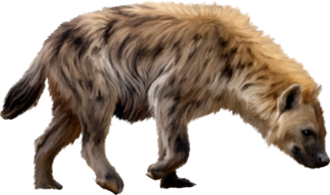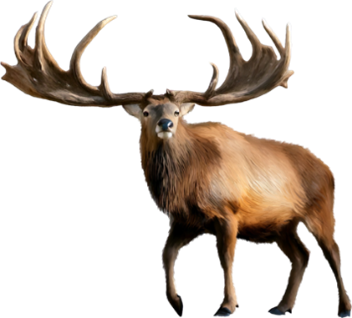The distribution of EXTINCT ANIMALS shown in the exhibition during the Ice Age and the extent of the ice sheet during the last major glaciation (approximately 20,000 years ago)

Woolly mammoth (Mammuthus primigenius)
During the glaciations, the woolly mammoth was a typical inhabitant of the mammoth steppe, a vegetation similar to today’s tundra steppe that was named after the large mammal. Frozen specimens survived almost intact in the permafrost of Siberia. Analyses of its stomach contents show that it fed on twigs of pines and cold-tolerant deciduous trees, as well as various steppe plants. During the summer, when food was plentiful, they grew fat in their bodies, which accumulated as a hump around their shoulders, so that they could endure prolonged fasting. From under the snow, they scooped out food with their tusks.

Sabre-toothed tiger (Smilodon populator)
The sabre-toothed tiger spread from North America to South America, where it caused significant destruction to megatheriums (ground sloths) and other ancient herbivore species. It is thought to have ambushed its prey, using its powerful front paws to strike down while inflicting deep wounds with its huge canines. Its long, fang-like teeth allowed the animal to open its mouth much wider than modern felines.

Cave hyena (Crocuta crocuta spelaea)
The cave hyena may have been a subspecies of the spotted hyena (Crocuta crocuta) adapted to cold climates. Its body was much larger than that of its modern relative. It preyed on large herbivores such as deer, wild horses and steppe bison (Bison priscus). It also had to fight other predators for hunting territory.

Giant short-faced hyena (Pachycrocuta brevirostris)
The giant short-faced hyena is the largest hyena species ever known. In size it approached that of the female lion alive today. As a large-bodied animal, it was more likely to feed on carrion, but it could also hunt cervids. From its habitat, it drove away hyenas smaller than itself, whose lifestyle was similar to its own.

Steppe bison (Bison priscus)
The Steppe bison was once the dominant herbivore of the vast grasslands of Eurasia and North America. It was highly adapted to open, steppe-like habitats, where it migrated in large herds in search of food. Its morphological characteristics are most similar to those of the forest subspecies of the American bison (Bison bison), particularly in terms of body structure and skull structure. It provided food for many large predators, such as the cave lion (Panthera spelaea).

Woolly rhinoceros (Coelodonta antiquitatis)
The woolly rhinoceros is thought to have migrated to Europe from Asia. It had two huge horns, a high crown on its molars, long fur to protect it from the cold and a lowered head. Its diet consisted of tough grasses and sedges, typical of steppe vegetation. Adults had no natural enemies, only calves and sick or injured individuals were attacked, mainly by big cats such as the cave lion (Panthera spelaea). Frozen carcasses have also been found in Siberia. Its closest living relative is the Sumatran rhinoceros (Dicerorhinus sumatrensis).

Glyptodon (Glyptodon clavipes)
The glyptodon was a slow-moving herbivore. Its head was covered with helmet-like armour. Its body was protected by leathery armour, and its tail was also covered with armour plates. Based on its teeth, it consumed coarse, fibrous, plant-based food crushing into a pulp with its flat, grooved teeth. Its main natural enemy was probably the sabre-toothed tiger (Smilodon populator), which mainly hunted younger individuals – it probably killed them by knocking them over and then wounding them in the belly, where they had no armour.

Cave bear (Ursus spelaeus)
The cave bear was one of the most common animals during the ice ages. Its bones have been found in large numbers in European caves. It was larger than today’s brown bear (Ursus arctos) and grew to the size of the American grizzly (Ursus arctos horribilis) living today. Its head was strikingly large in relation to its body. In Transylvania, its remains were believed to be dragon bones, and many people saw dragons flying out of its cave.

Irish elk (Megaloceros giganteus)
The Irish elk was much larger than its modern relatives. Its enormous palmate antlers could reach a span of 3.5 meters. Based on DNA tests, the fallow deer (Dama dama) is its closest living relative. It inhabited open, grassy, and marshy areas, avoiding forests. The largest number of its bone remains have been found in Irish peat bogs.

Aurochs (Bos primigenius)
The aurochs is the ancestor of all domestic cattle. It once lived in herds led by an experienced, elderly cow. The last specimen of the species died out in 1627. In the 1920s, using old cattle breeds, a breed very similar to the depictions of the aurochs was successfully bred back, which was named Heck cattle after the German stockman who worked hard to breed it.

Borson’s mastodon (Mammut borsoni)
Borson’s mastodon was one of the largest land mammals that ever lived. It fed primarily on the leaves and twigs of woody plants. It had enormous tusks; the largest known specimen was found in Greece, with tusks exceeding 5 meters in length.

Cave lion (Panthera spelaea)
The cave lion was the largest felines that ever lived. It was one-third larger than today’s lion (Panthera leo). Based on cave paintings, it can be assumed that this species did not have a mane or a tuft at the end of its tail, its ears were smaller, and its body was covered with long fur. Its exact taxonomic classification is still debated today, with some considering it a member of the tiger family and others of the lion family.

Southern mammoth (Mammuthus meridionalis)
The southern mammoth lived in Eurasia, and its remains have been found in numerous locations. Its ancestors originated in Africa. Its appearance resembled that of today’s African bush elephant (Loxodonta africana), and it is believed that it did not have thick fur. This animal lived during the early, warmer period of the Pleistocene. It probably preferred areas with a warm climate and lush vegetation, and mainly consumed succulent plant food.

Straight-tusked elephant (Elephas antiquus)
During the Pleistocene, the straight-tusked elephant spread across a large area during periods of warm climate between glaciations. It primarily preferred forest habitats. It had longer legs than its modern relatives.

Steppe mammoth (Mammuthus trogontherii)
The steppe mammoth, a descendant of the southern mammoth (Mammuthus meridionalis), was larger than any European mammoth. It is believed that these may have been the largest mammoths that ever existed. Its body was probably covered with thick fur. It may have evolved into the woolly mammoth (Mammuthus primigenius). In the Middle Pleistocene, it populated the grasslands of Europe and Asia.

Anancus (Anancus arvernensis)
The tusks of the anancus were mostly straight and free of enamel. Its skull was very similar to that of modern elephants, and like them, it probably had a hanging trunk. The species probably grazed and ate twigs, bark, seeds, and fruits.

Merck’s rhinoceros (Stephanorhinus kirchbergensis)
The Merck’s rhinoceros is the largest species in the family. It lived everywhere from grasslands to forests, but preferred the latter. It primarily consumed the branches and leaves of trees and shrubs, as well as low vegetation.

Megatherium (Megatherium americanum)
The megatherium (ground sloth) had huge claws on its feet: it moved slowly on the ground, standing on its hind legs and clinging to trees with its front legs to tear off branches and leaves for food. It often fell prey to sabre-toothed tigers.


